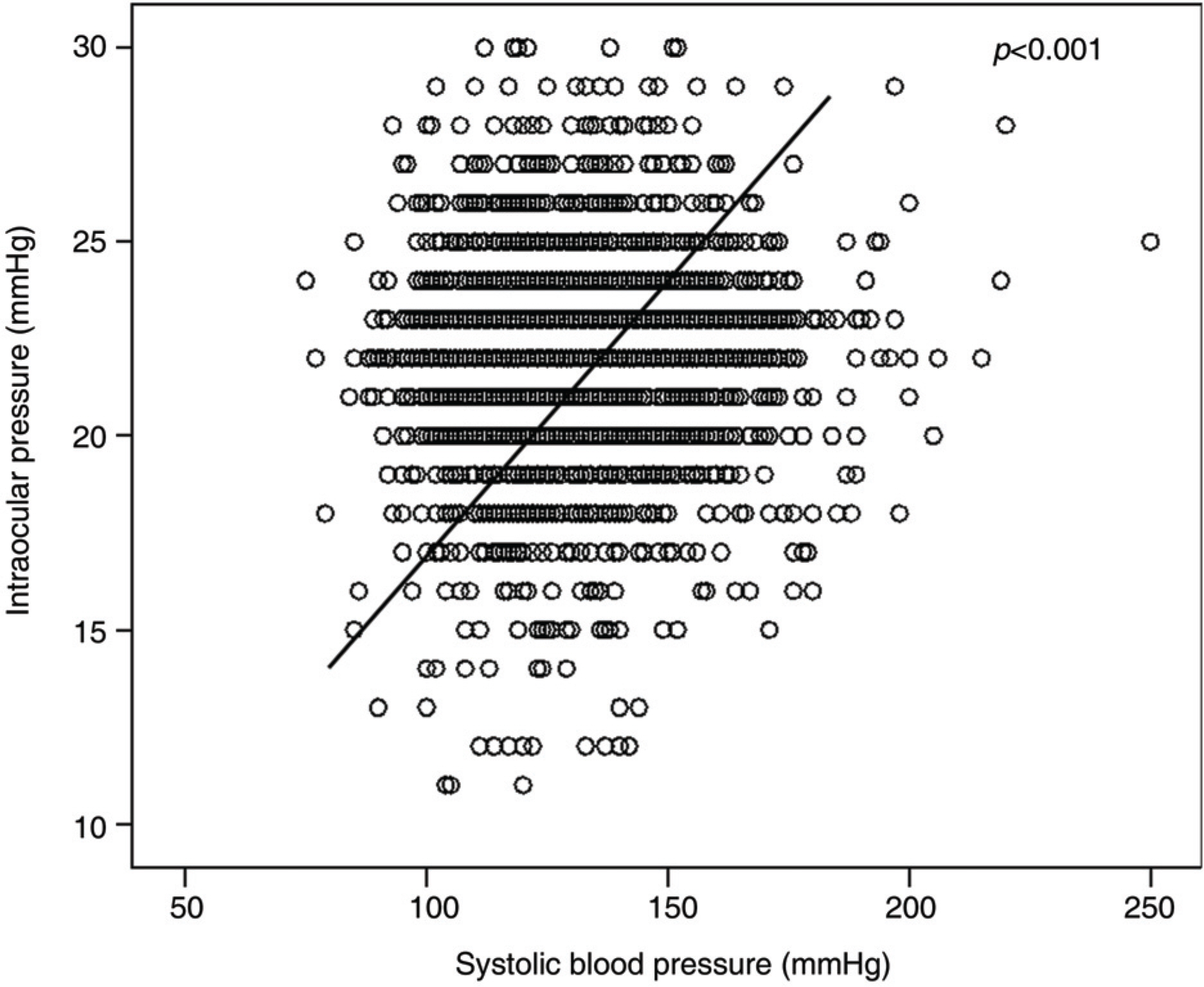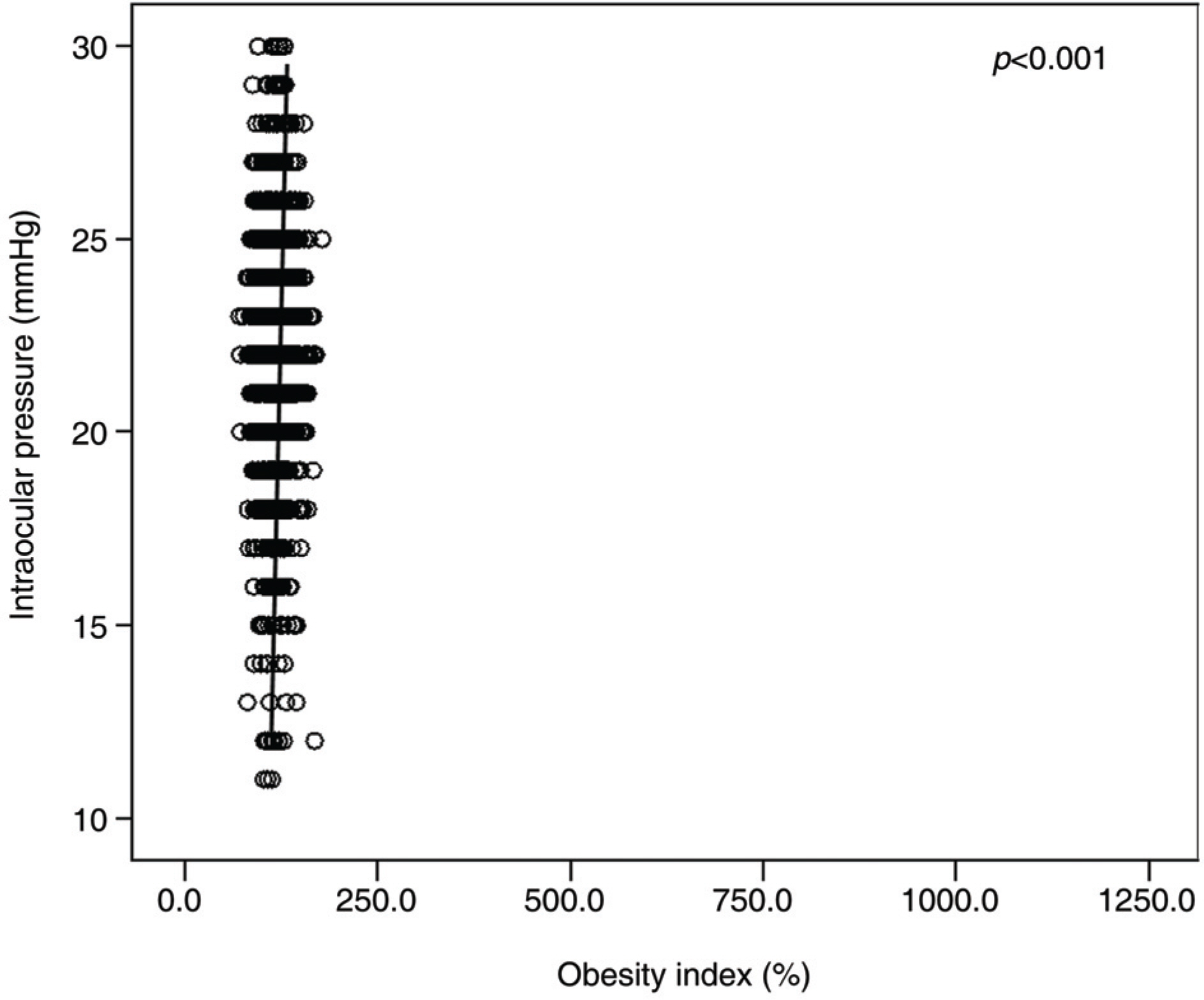J Korean Ophthalmol Soc.
2009 Jul;50(7):1082-1087. 10.3341/jkos.2009.50.7.1082.
The Relationship Between Intraocular Pressure and Age, Hypertension and Obesity Index in Ocular Hypertensive Patients
- Affiliations
-
- 1Department of Ophthalmology, Pusan National University Hospital, Busan, Korea. jongsool@pusan.ac.kr
- 2Department of Ophthalmic Optics, Gimhae College, Busan, Korea.
- KMID: 2212498
- DOI: http://doi.org/10.3341/jkos.2009.50.7.1082
Abstract
- PURPOSE
To evaluate the relationship between intraocular pressure (IOP) and age, blood pressure and obesity index inocular hypertensive patients. METHODS: A total of 2684 ocular hypertensive patients underwent automated multi-phasic testing, including fundus photography, blood pressure and assessment of obesity. The subjects were divided into six age groups by decades ranging from 20~29 years to over 70 years of age. The relationships between factors were examined using multiple regression analysis. RESULTS: The mean participant age was 48.0+/-11.0 years, and 1,777 (66.3%) participants were male and 907 (33.7%) were female. The mean intraocular pressure (IOP) was 22.04+/-2.2 mmHg and was significantly higher in males than in females (p=0.023). The IOP was associated with mean blood pressure, gender and obesity index. After adjustment for mean blood pressure and obesity index, the relationship between IOP and age showed a significantly negative tendency (p<0.001). The relationship between IOP and obesity index adjusted for age and mean blood pressure had a significantly positive tendency (p<0.001), regardless of gender. The relationship between IOP and mean blood pressure adjusted for age and obesity index showed a significantly positive tendency (p=0.00014). CONCLUSIONS: IOP was associated with the mean blood pressure and obesity index. Regardless of gender, IOP decreased with age but increased with hypertension. It is necessary to check IOP regularly, especially in ocular hypertensive patients with systemic hypertension.
MeSH Terms
Figure
Cited by 1 articles
-
Cross-Sectional Study between Anthropometric Obesity Indices and Intraocular Pressure
Jong Soo Lee, Sun Joo Kim, Young Min Park
J Korean Ophthalmol Soc. 2015;56(3):379-387. doi: 10.3341/jkos.2015.56.3.379.
Reference
-
References
1. Meckenzie W. Practical treatise on the disease of the eye. 2nd ed.London: Longman;1835. p. 822.2. Jung SK, Lee SK, Kim JH. Intraocular pressure change by the hemodialysis. J Korean Ophthalmol Soc. 1995; 36:2195–201.3. Drance SM, Sweeney VP, Morgan RW, Feldman F. Studies offactors involved in the production of low-tension glaucoma. Arch Ophthalmol. 1973; 89:457–65.4. Gasser P. Ocular vasospasm: A risk factor in the pathogenesis of low tension glaucoma. Int Ophthalmol. 1989; 13:281–90.5. Rojanapongpun P, Drance SM. The response of blood flow velocity in the ophthalmic artery and cold stimuli in glaucomatous patients. Graefes Arch Clin Ophthalmol. 1993; 231:375–7.6. Demailly P, Cambien F, Plouin PF. Do patient with low tension glaucoma have particular cardiovascular characteristics? Ophthalmologica. 1984; 188:65–75.7. Kaiser HJ, Flammer J. Systemic hypotension: a risk factor for glaucomatous damage? Ophthalmologica. 1991; 203:105–8.
Article8. Hollows FC, Graham PA. Intraocular pressure, glaucoma and glaucoma suspects in a defined population. Br J Ophthalmol. 1966; 50:570–86.
Article9. Carel RS, Korczyn AD, Rock M, Goya I. Association between ocular pressure and certain health parameters. Ophthalmology. 1984; 91:311–4.
Article10. Schulzer M, Drance SM. Intraocular pressure, systemic blood pressure, and age: a correlation study. Br J Ophthalmol. 1987; 71:245–9.11. Kahn HA, Leibowwitz HM, Ganly JP, et al. The Framlingham Eye Study: 2. Association of ophthalmic pathology with single variables previously measured in Framlingham Heart Study. Am J Epidemiol. 1977; 106:33–41.12. Shiose Y, Kawase Y. A new approach to stratified normal intraocular pressure in a general population. Am J Ophthalmol. 1986; 101:714–21.
Article13. Shiose Y. The aging effect on intraocular pressure in an apparently normal population. Arch Ophthalmol. 1984; 102:883–7.
Article14. Qureshi IA. Intraocular pressure: a comparative analysis in two sexes. Clin Physiol. 1997; 17:247–55.
Article15. Nomura H, Shimokata H, Ando F, et al. Age-related changes in intraocular pressure in a large Japanese population. Ophthalmology. 1999; 106:2016–22.
Article16. Leske MC, Connell AM, Wu SY, et al. Distribution of intraocular pressure: the Barbados Eye Study. Arch Ophthalmol. 1997; 115:1051–7.17. Mori K, Ando F, Nomura H, et al. Relationship between intraocular pressure and obesity in Japan. Int J Epidimiol. 2000; 29:661–6.
Article18. Lee JS, Kim CM, Choi HY, Oum BS. A relationship between intraocular pressure and age and body mass index in a korean population. J Korean Ophthalmol Soc. 2003; 44:1559–66.19. Kwon GR, Kang SW, Kee C. The influence of central corneal thickness on intraocular pressures measured with goldmann applanation tonometer and non-contact tonometer. J Korean Ophthalmol Soc. 1998; 39:1494–8.20. Bae GJ, Han TW, Ahn MD, Kim JH. Comparison of the non-contact tonometer with goldmann Tonometer. J Korean Ophthalmol Soc. 1992; 33:642–8.21. Kass MA, Zimmerman TJ, Alton E, et al. Intraocular pressure and glaucoma in the Zuni indians. Arch Ophthalmol. 1978; 96:2212–3.
Article22. Klein BE, Klein R, Linton KL. Intraocular pressure in an american community. The Beave Dam Eye study. Invest Ophthalmol Vis Sci. 1992; 33:2224–8.23. Stoupel E, Goldenfeld M, Shimshoni M, Siegel R. Intraocular pressure in relation to four levels of daily geomagnetic and extreme yearly solar activity. Int J Biometeorol. 1993; 37:42–5.24. Bulpitt CJ, Hodes C, Everott MG. Intraocular pressure and systemic blood pressure in the elderly. Br J Ophthalmol. 1975; 59:717–20.
Article25. Kass MA, Sears ML. Hormonal regulation of intraocular pressure. Surv Ophthalmol. 1977; 22:153–76.
Article26. Matsuki S, Suzuki A. Definition, judgement and epidemiology of obesity. Clin Adult Dis. 1979; 9:919–23.27. Jung SC, Choi YR, Lee JS. The relationship between intraocular pressure and cardiovascular risk factors. J Korean Ophthalmol Soc. 2005; 46:1518–25.28. Katavisto M, Sammalkivi J. Tonometry among persons over 40 years of age. Acta Ophthalmol Scand. 1964; 42:370–7.
- Full Text Links
- Actions
-
Cited
- CITED
-
- Close
- Share
- Similar articles
-
- Intraocular Pressure Change used Topical 0.1% Fluorometholone in Children after Strabismus Surgery
- Relationship between intraocular pressure and systemic health parameters in the Korean population
- A Relationship between Intraocular Pressure and Age and Body Mass Index in a Korean Population
- The Relationship Between Intraocular Pressure and Health Parameters
- Postural Change of Intraocular Pressure in Normal Persons and in Patients with Hypertension and Diabetes






